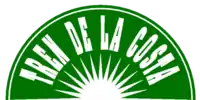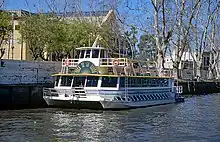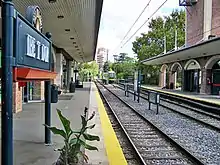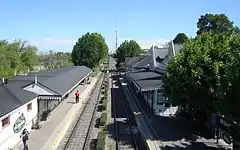Tren de la Costa
Tren de la Costa (in English: "Train of the Coast") is a suburban 15.5 km (9.6 mi), 11-station light rail line in Greater Buenos Aires, between Maipú Avenue station in the northern suburb of Olivos and Delta station in Tigre, on the Río de la Plata. The line connects with the Mitre line at Maipú station, via a footbridge across Avenida Maipú, for direct access to Retiro terminus in central Buenos Aires.
.jpg.webp) One of the CAF-built light rail cars that serve the line | |||||
| Overview | |||||
|---|---|---|---|---|---|
| Service type | Light rail | ||||
| Status | Active | ||||
| Locale | Greater Buenos Aires | ||||
| Predecessor | Mitre Railway | ||||
| First service | 1995 | ||||
| Current operator(s) | Trenes Argentinos (2013–present) | ||||
| Former operator(s) | Sociedad Comercial del Plata (1995–2013) | ||||
| Ridership | 300,246 (2021)[1] | ||||
| Website | Tren de la Costa | ||||
| Route | |||||
| Termini | Maipú Delta | ||||
| Stops | 11 | ||||
| Distance travelled | 15.5 km (9.6 mi) | ||||
| Average journey time | 30' | ||||
| Service frequency | 30' | ||||
| Technical | |||||
| Track gauge | 1,435 mm (4 ft 8+1⁄2 in) standard gauge | ||||
| Operating speed | 30 km/h (19 mph) | ||||
| Track owner(s) | Government of Argentina | ||||
| |||||
Tren de la Costa is served by nine two-car trains sets. Each train has a capacity of 200 passengers and travels at an average speed of 35 km/h. The journey time is 30 minutes, with a frequency of 30 minutes. The service is currently operated by State-owned Trenes Argentinos Operaciones.
History


Tren de la Costa | ||||||||||||||||||||||||||||||||||||||||||||||||||||||||||||||||||||||||||||||||||||||||||||||||||||||||||||||||||||||||||||||
|---|---|---|---|---|---|---|---|---|---|---|---|---|---|---|---|---|---|---|---|---|---|---|---|---|---|---|---|---|---|---|---|---|---|---|---|---|---|---|---|---|---|---|---|---|---|---|---|---|---|---|---|---|---|---|---|---|---|---|---|---|---|---|---|---|---|---|---|---|---|---|---|---|---|---|---|---|---|---|---|---|---|---|---|---|---|---|---|---|---|---|---|---|---|---|---|---|---|---|---|---|---|---|---|---|---|---|---|---|---|---|---|---|---|---|---|---|---|---|---|---|---|---|---|---|---|---|
| ||||||||||||||||||||||||||||||||||||||||||||||||||||||||||||||||||||||||||||||||||||||||||||||||||||||||||||||||||||||||||||||
The original line was constructed between 1891 and 1896 as part of the Buenos Aires and Rosario Railway (BA&R) connecting Coghlan junction in the Buenos Aires neighbourhood of Belgrano with the port of Tigre and was known as the Tren del Bajo. Tracks ran following the course of the river, serving as an alternative route to Tigre, which was already served by the Buenos Aires Northern Railway.
The line was later absorbed by the Central Argentine Railway when this company took over the (BA&R) in 1908. The line was electrified in 1931 and after nationalisation in 1948, it became part of General Mitre Railway. In 1961 the Government of Argentina led by President Arturo Frondizi closed the B. Mitre-Delta branch due to the low number of passengers carried and high maintenance costs.[2]
In 1990 plans were formulated for the reopening of the line and with the railways being privatised in 1992, the Tren de la Costa company (part of Sociedad Comercial del Plata, controlled by local businessman Santiago Soldati) was formed to take over the concession for the service.
The track was converted from 5 ft 6 in (1,676 mm) broad gauge to 1,435 mm (4 ft 8+1⁄2 in) standard gauge, and re-electrified utilising an overhead system rather than the former third rail in 1994. Public services and related commercial operations began in April 1995, and the maiden ride was shared by Soldati, company and government officials, and President Carlos Menem.

The company remodelled the eight stations of the branch and built three new stations, most of them with the concept of shopping mall centres, with San Isidro being the most representative of this. A new terminus, named "Maipú" was built just in front of former Bartolomé Mitre terminus. Both stations were connected through a pedestrian bridge over Maipú Avenue. Unlike the Retiro-B. Mitre branch, the new Maipú-Delta service was a light rail system, using articulated cars acquired from Spanish company Construcciones y Auxiliar de Ferrocarriles (CAF).
During the first years of service, the branch carried an average of 100,000 passengers (on weekends) due to it having been conceived as a tourist train, with Maipú, Libertador and San Isidro as its main commercial centres. Beside the Delta terminus, a new amusement park, Parque de la Costa was built, advertised as the largest in South America. Two years later, the Trillenium Casino opened beside the park and Delta station. These projects, as well as the shopping malls, were designed to be part of the "de la Costa" franchise.
Passenger numbers dropped significantly over the years following the opening of the line in 1995. Around 100,000 journeys were made each weekend initially; but, by 2005 there were just 150,000 a month, a third of which were foreign tourists.[3] While the economy later improved, this did not reverse the falloff in ridership, which declined to around 70,000 a month by 2010.[4] This affected both the railway and the amusement park. The SCP applied to the national government for a grant, but this was denied as the line was categorised as a tourist train, rather than one for public passenger transport. Most shops along the line closed.[5][6][7] The Government of Argentina revoked the concession to SCP,[8] taking over the Tren de la Costa through its subsidiary SOFSE.[9][10] This decision was published in the Argentine Official Bulletin on 3 Jun 2013.[11]
Concept

The line and its stations were conceived to offer various forms of entertainment and enjoyment for both adults and children, being used by both tourists and commuters. Each station,[12] seven of which are original stations refurbished, has history and art displays, and substantial shopping areas were built at Maipú, Libertador and San Isidro. Borges Station, by the Olivos marina, was planned as 'the station of the arts' with an art café with open-air sculptures. Located nearby is the Juan Carlos Altavista Cinema (former "Cine York"), one of the oldest still operating in the world. Anchorena station was nicknamed The Tango station due to its cultural centre, and Barrancas station hosts an antiques fair.
The route between Libertador and San Isidro was adapted for use by walkers, joggers and cyclists. Delta station serves the Parque de la Costa, an amusement park, as well as Tigre's other important tourist attractions including the Trillenium Casino, a crafts fair, riverside restaurants and boat trips.
Stations


| Station | Partido | Facilities |
|---|---|---|
| Maipú | Vicente López | Accessible toilets, Parking lot, Coffeehouse, access to Mitre Line |
| Borges | Accessible toilets, Coffeehouse | |
| Libertador | Accessible toilets, Parking lot, Coffeehouse, Supermarket, Retail | |
| Anchorena | San Isidro | Accessible toilets, Parking lot, Coffeehouse |
| Barrancas | Accessible toilets, Coffeehouse | |
| San Isidro R | Accessible toilets, Parking lot, Coffeehouse, Supermarket, Retail, Cinema | |
| Punta Chica | Accessible toilets, | |
| Marina Nueva | San Fernando | Accessible toilets, Coffeehouse |
| San Fernando R | Accessible toilets | |
| Canal | Accessible toilets, Coffeehouse | |
| Delta [lower-alpha 1] | Tigre | Accessible toilets, Coffeehouse, access to Parque de la Costa, river bus station [lower-alpha 2] and Trilenium Casino |
New stations built by concessionary Sociedad Comercial del Plata. | ||
Notes
- The original Delta station building was inhabited by intruders when the concession was granted. To avoid delays, it was decided to build a new station some metres to the south until the problem was solved. Nowadays the original station building is operating as a restaurant.
- The boat station (renamed "Estación Fluvial Domingo F. Sarmiento"[15]) is the original BA&R's Tigre station building. When TBA opened a new terminus in 1995, the old building fell into disuse. The Municipality of Tigre restored the building in 2000,[16] currently serving as the river bus station.
References
- Informe estadístico 2021 at Trenes Argentinos
- La línea Maipú-Delta, un potencial desaprovechado - EnElSubte, 20 April 2015.
- "El Tren de la Costa ya cumplió 10 años y no termina de arrancar", Clarín, 10 Nov 2005
- "Servicios Públicos", INDEC, 30 April 2010
- "Tren de la Costa: la abrupta caída de usuarios precipitó el final de una época de oro", La Nación, 28 Jun 2013
- "Tren de la Costa: del paseo de lujo a un objeto de colección", Clarín, 23 Apr 2012
- "Abandono y desolación en las estaciones del Tren de la Costa", Perfil, 23 Sep 2012 Archived 13 April 2014 at the Wayback Machine
- "El Ministerio de Transporte le rescindió el contrato al Tren de la Costa por incumplimiento", Telam, 4 Jun 2013]
- "Estatizan el Tren de la Costa, terrenos del Parque y dos ramales de cargas ferroviarias", La Nación, 5 June 2013
- "Tren y Parque de la Costa pasan a manos del Estado", Página/12, 5 Jun 2013
- Resolución 477/2013 - Boletín Oficial de Argentina
- "Estaciones en la Costa", by Pablo Guiraldes, Summa+ magazine #14
- "Un viaje al pasado en el Bajo de Acassuso", La Nación, 9 Feb 2010
- "Feria de Anticuarios: tesoros y pasiones de coleccionistas", Clarín, 19 Feb 2012
- "Transporte Fluvial" on Municipalidad de Tigre website Archived 2015-02-05 at archive.today
- "Estación Fluvial: información"
External links
- Official website

- Tren de la Costa (unofficial)

.jpg.webp)